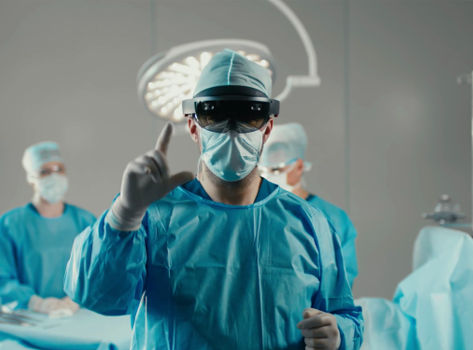As a nationally-recognized leader in innovation medicine and high-quality health care, Atlantic Health System is once again pioneering the latest cutting-edge technology to improve patient outcomes — this time, advancing mixed reality technology with HoloLens and expanding the use in orthopedic operating rooms.
According to John Erickson, MD, an orthopedic surgeon with Atlantic Health System, the HoloLens allows surgeons to prepare 3D models before surgery, safely access information during procedures and improve communication within the operating room. And that’s just the beginning. “We’re only just getting started,” says Dr. Erickson. “The platform has near-endless capabilities, all of which can lead to better patient outcomes, so the better question is, ‘What can’t it do?’”

Photo Credit: Microsoft.
What is the HoloLens?
HoloLens is the name of the head-mounted mixed reality device that Atlantic Health orthopedic surgeons are using to improve patient outcomes.
Similar to goggles, the hardware resembles a VR (virtual reality) gaming headset —a wireless head piece with transparent lenses. But unlike VR, which is a fully immersive digital environment, mixed reality technology gives the user a view of the real world with digital image overlays (holograms) that can be manipulated in real time. In other words, the HoloLens is a pair of goggles that allow the wearer to see 3D images and interact with them in midair using hand or finger gestures.
How is Atlantic Health Using HoloLens in Orthopedic Surgery?
Atlantic Health orthopedic surgeons are using HoloLens to prepare for surgery and augment reality in the operating room.
“Right now, we’re successfully using the HoloLens in orthopedic surgery for joint replacements, upper arm fractures, and other traumas,” reveals Dr. Erickson. “The biggest areas where it has helped us is in preoperative planning, intraoperative execution, and OR team dynamics.”
Preoperative Planning
Before any procedure, surgeons prepare by reviewing patient files and imaging scans to plot a course of action. With HoloLens, Dr. Erickson can build 3D models of his patient’s exact anatomy to practice, prepare, and plan for the procedure ahead, thereby reducing unexpected complications.
Intraoperative Execution
Once in the OR, Dr. Erickson uses the HoloLens to put his preoperative plan into action. With HoloLens, he’s able to have sterile access to patient anatomy and images.
Without ever having to take his eyes off his patient on the operating table, he can access holographic images of patient CT scans and other files to confirm information or change course. The holograms are seen as an overlay in his field of vision, thereby keeping the surgical field sterile without interfering with his workflow.
Team Dynamics
When nurses, scrub techs, and other OR staff wear the HoloLens, Dr. Erickson can share the technology, giving them the same “view” that he has so they know exactly where he needs something to go. It also allows the surgical staff to virtually access PDF files with operational information and other useful data to improve team communication and workflow.
How do Patients Benefit from HoloLens Technology?
As Dr. Erickson explains, anything that helps the surgical team do their job more efficiently ultimately helps the patient. He considers the HoloLens a “do no harm” device, meaning if the technology glitches during a procedure or doesn’t give him an advantage, he can simply have a team member flip the lens up and continue working — and there’s no harm to the patient because the device never touches the patient and doesn’t cause any problems with OR sterility.
Additionally, the HoloLens’s preoperative capabilities — designing 3D models and segmenting images — make him a more prepared surgeon, which leads to improved patient outcomes.
“When I meet with patients to discuss their surgical plan and demonstrate how I use the HoloLens, they are blown away and know that I’m giving them every advantage possible to achieve an optimal outcome,” Dr. Erickson says.
What’s Next? Future Applications of HoloLens at Atlantic Health
Right now, Dr. Erickson is one of only a handful of surgeons in the U.S. who are skilled in the HoloLens platform. To date, he has successfully performed over 100 procedures such as shoulder replacement surgeries, fracture repairs, and trauma procedures using HoloLens mixed reality technology — and he’s excited about future applications.
Mixed reality has already proven to be a useful training tool for junior surgeons, and Dr. Erickson is eager for the day when the device can also be used as a navigation tool, similar to robotics. “Robotic surgery is very accurate, but also very specific, so it’s limited,” explains Dr. Erickson. “The HoloLens platform does many things efficiently. It’s a great tool with great potential to make the hardest cases easier and reduce outliers, ultimately leading to more consistent patient outcomes.”
“We’re collecting data now and will soon be able to demonstrate unequivocally how using the HoloLens reduces complications and gives us improved reproducible outcomes, which is the ultimate goal with patient care.”
Read more about Atlantic Health’s use of mixed reality technology >
Be Proactive About Your Health
To stay safe and healthy, it's good to have a primary care provider who knows and understands your health history and wellness goals.